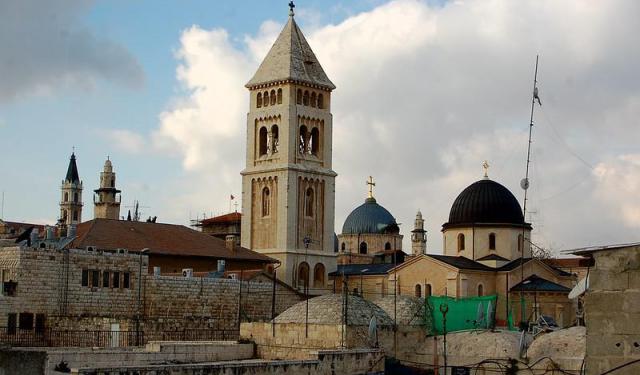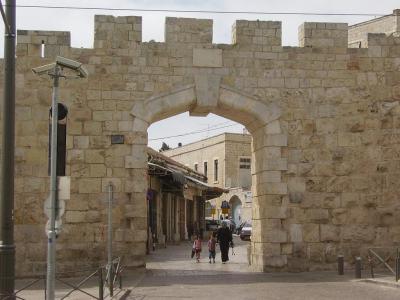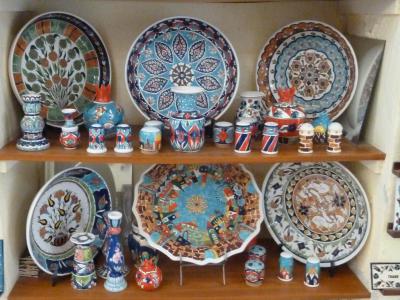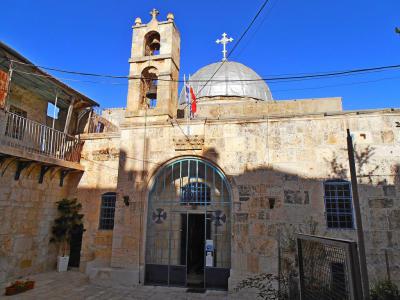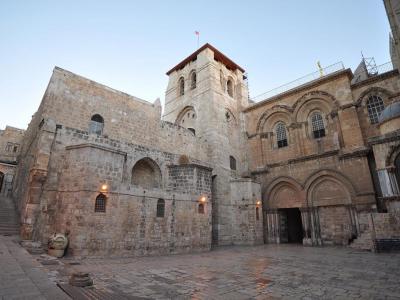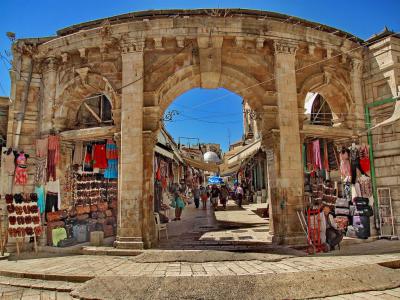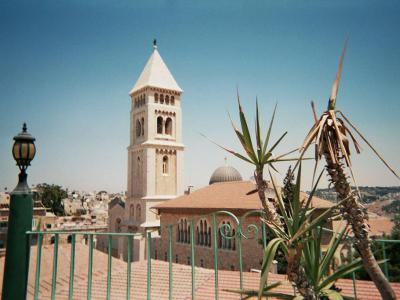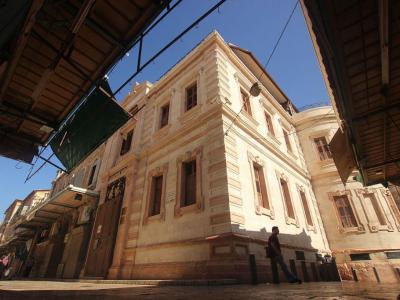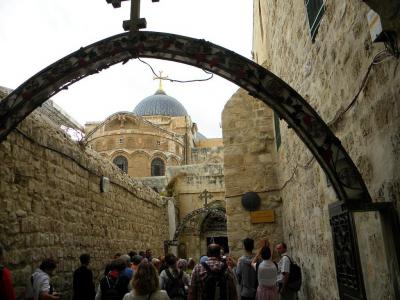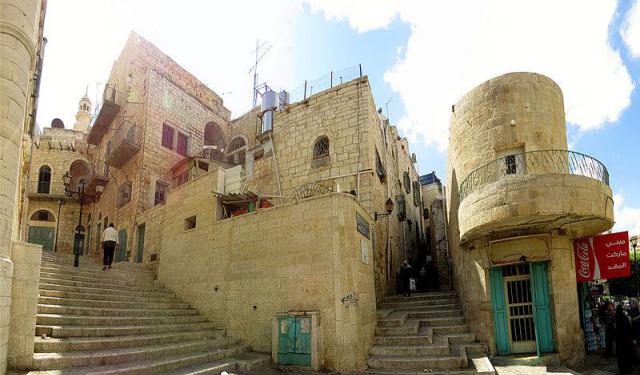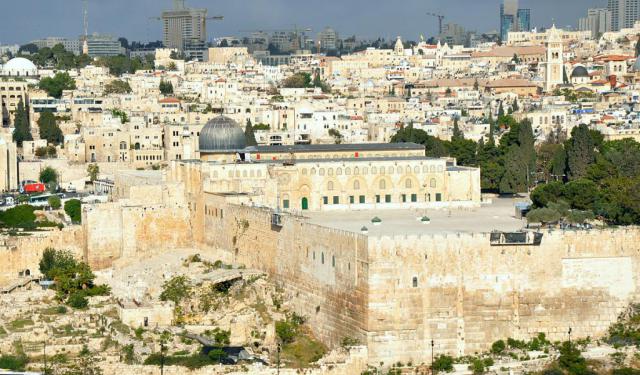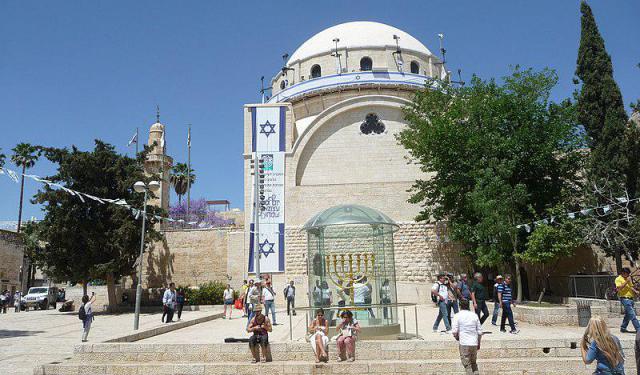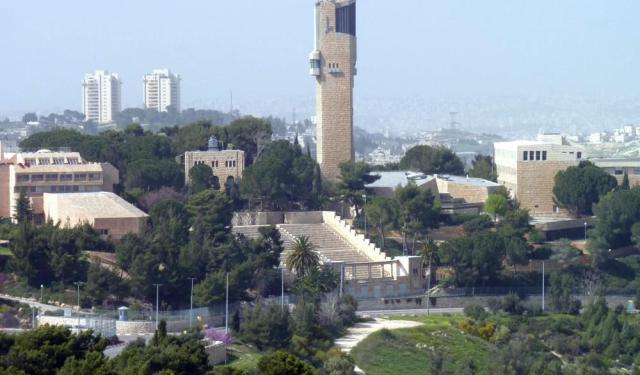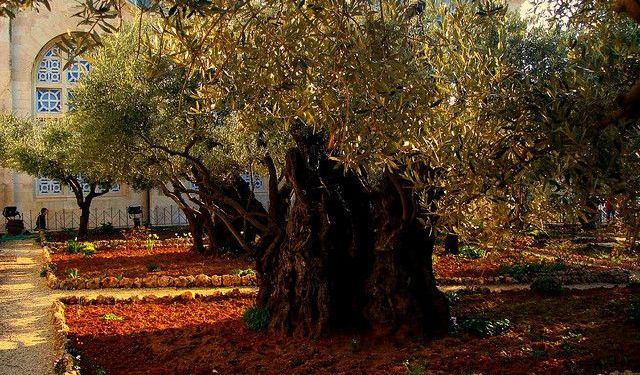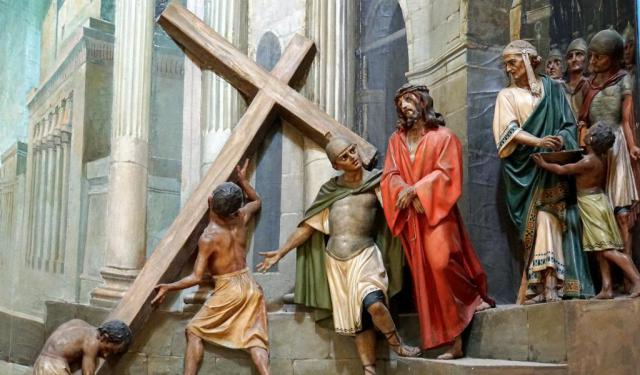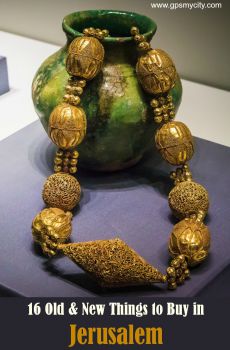Christian Quarter Walking Tour (Self Guided), Jerusalem
One of the epicenters of worldwide Christianity, the Christian Quarter is the 2nd-largest of Jerusalem’s four ancient quarters. A fascinating place to stroll through, it covers the Old City’s northwestern part, just beyond Jaffa Gate – the traditional pilgrim’s entrance to Jerusalem and a prime destination for most visitors.
With its tangle of broad streets and winding, narrow alleys, this area houses one of the holiest sites for all Christians – the Church of the Holy Sepulchre, a magnificent and timeworn edifice built over what is believed to be the sites of the crucifixion, entombment and resurrection of Christ.
Dominated by this multi-denominational temple, the quarter is also home to other prominent sites, such as the neo-Romanesque Lutheran Church of the Redeemer (climb its bell tower for great all-round views of East and West Jerusalem!), a colorful example of a Russian Orthodox church (sitting atop fascinating Roman ruins beneath), as well as the Muristan/Aftimos complex, packed with outdoor cafes, eateries, and stores.
You’ll even get to see some of the stations along Via Dolorosa, where Jesus carried his cross on his way to be crucified, along with some additional bits of history that came well after Jesus’s time.
To explore the Christian Quarter in more detail, join us on this self-guided walking tour!
With its tangle of broad streets and winding, narrow alleys, this area houses one of the holiest sites for all Christians – the Church of the Holy Sepulchre, a magnificent and timeworn edifice built over what is believed to be the sites of the crucifixion, entombment and resurrection of Christ.
Dominated by this multi-denominational temple, the quarter is also home to other prominent sites, such as the neo-Romanesque Lutheran Church of the Redeemer (climb its bell tower for great all-round views of East and West Jerusalem!), a colorful example of a Russian Orthodox church (sitting atop fascinating Roman ruins beneath), as well as the Muristan/Aftimos complex, packed with outdoor cafes, eateries, and stores.
You’ll even get to see some of the stations along Via Dolorosa, where Jesus carried his cross on his way to be crucified, along with some additional bits of history that came well after Jesus’s time.
To explore the Christian Quarter in more detail, join us on this self-guided walking tour!
How it works: Download the app "GPSmyCity: Walks in 1K+ Cities" from Apple App Store or Google Play Store to your mobile phone or tablet. The app turns your mobile device into a personal tour guide and its built-in GPS navigation functions guide you from one tour stop to next. The app works offline, so no data plan is needed when traveling abroad.
Christian Quarter Walking Tour Map
Guide Name: Christian Quarter Walking Tour
Guide Location: Israel » Jerusalem (See other walking tours in Jerusalem)
Guide Type: Self-guided Walking Tour (Sightseeing)
# of Attractions: 8
Tour Duration: 1 Hour(s)
Travel Distance: 1.1 Km or 0.7 Miles
Author: vickyc
Sight(s) Featured in This Guide:
Guide Location: Israel » Jerusalem (See other walking tours in Jerusalem)
Guide Type: Self-guided Walking Tour (Sightseeing)
# of Attractions: 8
Tour Duration: 1 Hour(s)
Travel Distance: 1.1 Km or 0.7 Miles
Author: vickyc
Sight(s) Featured in This Guide:
- New Gate
- Jerusalem Pottery Hagop Karakashian
- Church of St. John the Baptist
- Church of the Holy Sepulchre / Christ's Tomb
- Muristan / Aftimos Market
- Lutheran Church of the Redeemer
- Church of St. Alexander Nevsky
- Via Dolorosa (Way of Sorrow)
1) New Gate
The New Gate stands as a unique addition to Jerusalem's Old City wall, diverging from the original 16th-century design. Erected in 1889 during the twilight of the Ottoman Empire, it holds historical significance distinct from the Second Temple's New Gate referenced in the Book of Jeremiah. Positioned at 790 meters (2,590 ft) above sea level, it represents the highest point along the Old City wall, serving as the swiftest pedestrian route between West Jerusalem and various quarters of the Old City.
Also referred to as “Bab es Sultan Abd ul Hamid”, the gate owes its existence to the Ottoman Sultan who acquiesced to the French Consul's plea for access to the Old City from the Notre Dame Hospice, completed in 1886. Additionally, it aimed to facilitate direct passage for Russian pilgrims residing at the Russian Compound to reach the Church of the Holy Sepulchre in the Christian Quarter.
Throughout the 20th century, the New Gate endured multiple assaults from various parties. In 1929, an unprovoked Arab attack resulted in the loss of several Jewish lives, while in 1945, an Israeli paramilitary group attempted to demolish a section of the adjacent wall (though their efforts were thwarted by a malfunction in the explosive device). During the 1948 Arab-Israeli war, a Jewish demolition charge intended for the gate was triggered by a stray artillery shell, igniting the Arab wooden barricade nearby. Subsequently, the gate was sealed off by the Jordanian occupation administration until its reopening in 1967 by the Israeli Army following the Six-Day War.
Also referred to as “Bab es Sultan Abd ul Hamid”, the gate owes its existence to the Ottoman Sultan who acquiesced to the French Consul's plea for access to the Old City from the Notre Dame Hospice, completed in 1886. Additionally, it aimed to facilitate direct passage for Russian pilgrims residing at the Russian Compound to reach the Church of the Holy Sepulchre in the Christian Quarter.
Throughout the 20th century, the New Gate endured multiple assaults from various parties. In 1929, an unprovoked Arab attack resulted in the loss of several Jewish lives, while in 1945, an Israeli paramilitary group attempted to demolish a section of the adjacent wall (though their efforts were thwarted by a malfunction in the explosive device). During the 1948 Arab-Israeli war, a Jewish demolition charge intended for the gate was triggered by a stray artillery shell, igniting the Arab wooden barricade nearby. Subsequently, the gate was sealed off by the Jordanian occupation administration until its reopening in 1967 by the Israeli Army following the Six-Day War.
2) Jerusalem Pottery Hagop Karakashian
Surprisingly, Jerusalem stands as the sole remaining hub for the production of authentic Armenian ceramics worldwide. Characterized by traditional glazes crafted from metallic oxides, alongside hand-painted designs, Armenian pottery is renowned for its distinctiveness. Vibrant yet grounded hues, notably cobalt blue, take center stage, often featuring the peacock motif symbolizing longevity.
In the 18th century, numerous Armenian artisans, masters of this craft, resided in Turkey. In 1919, the British government summoned Armenian craftsmen to restore the ceramic tiles on the Dome of the Rock mosque in Jerusalem. Among them were members of the Karakashian family, who settled in the city and established the esteemed Jerusalem Pottery.
The shop proudly showcases an extensive array of ceramics, often featuring Christian themes, some exuding joviality, particularly evident in wall plaques. Additionally, traditional crockery such as plates, bowls, mugs, and platters, alongside wooden trays adorned with embedded tiles, all brightly colored, featuring floral motifs, Persian-style hares, or deer, grace the collection. Each piece bears the unmistakable touch of authenticity, hand-painted and signed by the skilled artisans of the Karakashian Brothers.
A word of caution:
While these vessels are perfect for serving, they are not suitable for microwave or oven use. Beware of imitation pieces mass-produced in Hebron factories, which may lack the durability and craftsmanship of genuine Armenian pottery.
In the 18th century, numerous Armenian artisans, masters of this craft, resided in Turkey. In 1919, the British government summoned Armenian craftsmen to restore the ceramic tiles on the Dome of the Rock mosque in Jerusalem. Among them were members of the Karakashian family, who settled in the city and established the esteemed Jerusalem Pottery.
The shop proudly showcases an extensive array of ceramics, often featuring Christian themes, some exuding joviality, particularly evident in wall plaques. Additionally, traditional crockery such as plates, bowls, mugs, and platters, alongside wooden trays adorned with embedded tiles, all brightly colored, featuring floral motifs, Persian-style hares, or deer, grace the collection. Each piece bears the unmistakable touch of authenticity, hand-painted and signed by the skilled artisans of the Karakashian Brothers.
A word of caution:
While these vessels are perfect for serving, they are not suitable for microwave or oven use. Beware of imitation pieces mass-produced in Hebron factories, which may lack the durability and craftsmanship of genuine Armenian pottery.
3) Church of St. John the Baptist
The gleaming silver dome rises prominently above the Muristan, offering a striking sight against the city's skyline. Yet, amidst the bustling crowds along the lively Christian Quarter Road, the entrance to this historic landmark may prove elusive. A modest doorway grants access to a courtyard, which in turn grants access to both the adjoining Greek Orthodox monastery and the church itself.
Dating back to the 5th century, the Church of Saint John the Baptist ranks among Jerusalem's oldest religious sites. Despite periods of dilapidation, extensive reconstruction in the 11th century restored its grandeur, with only the later-added bell towers altering its original form. As a Greek Orthodox establishment, it has a resplendent gilded altar screen and is decorated with icons venerating John the Baptist. Notably, one such icon, located just inside the entrance on the right, reputedly houses a fragment of the saint's skull.
In 1099, amidst the tumult of the siege of Jerusalem, this church served as a refuge for Christian knights wounded in battle. Upon recorvery, these knights, inspired by their experiences, pledged themselves to aiding the infirm and safeguarding pilgrims journeying to Jerusalem. Thus, they established the Knights of the Hospital of Saint John, an order that would evolve into the military order of the Hospitallers, playing a pivotal role in defending the Holy Land throughout the Crusades.
Dating back to the 5th century, the Church of Saint John the Baptist ranks among Jerusalem's oldest religious sites. Despite periods of dilapidation, extensive reconstruction in the 11th century restored its grandeur, with only the later-added bell towers altering its original form. As a Greek Orthodox establishment, it has a resplendent gilded altar screen and is decorated with icons venerating John the Baptist. Notably, one such icon, located just inside the entrance on the right, reputedly houses a fragment of the saint's skull.
In 1099, amidst the tumult of the siege of Jerusalem, this church served as a refuge for Christian knights wounded in battle. Upon recorvery, these knights, inspired by their experiences, pledged themselves to aiding the infirm and safeguarding pilgrims journeying to Jerusalem. Thus, they established the Knights of the Hospital of Saint John, an order that would evolve into the military order of the Hospitallers, playing a pivotal role in defending the Holy Land throughout the Crusades.
4) Church of the Holy Sepulchre / Christ's Tomb (must see)
One of the most revered destinations in the Old City, this site holds unparalleled significance for Christians worldwide. Commonly referred to as the Church of the Resurrection, its somber, cavernous interior encompasses four stations of the Via Dolorosa, drawing crowds of pilgrims year-round. (The terminus of the Via Dolorosa lies just beyond the expansive outdoor courtyard.)
Welcoming visitors at the entrance is the Chapel of the Franks, leading to the towering interior featuring a Greek Orthodox crucifixion altar, believed to mark the spot of Jesus' crucifixion. Adjacent to it, the prominent Stone of Unction serves as a reminder of the place where Jesus's body was prepared for burial. Further inside, past the Chapel of the Angel, lies a marble-encased tomb, purportedly the very place where Jesus was laid to rest. A majestic vaulted dome crowns the tomb, emanating a solemn stream of light from above.
Commissioned by Constantine the Great following his conversion to Christianity in AD 326, the church has weathered centuries of neglect, desecration, and damage amid shifting rulership in the city. A collaborative restoration effort in 1959, spearheaded by the Latin, Greek, and Armenian communities, preserved what could be salvaged. The resulting structure is a patchwork of Byzantine, Crusader, medieval, and modern architectural styles. Control of the church is scrupulously divided among various Christian denominations, with disputes over custodial responsibilities even extending to the cleaning of steps.
Tip:
It's advisable to arrive early and come prepared, as signage and guided tours are scarce. Proper attire is essential for entry.
Welcoming visitors at the entrance is the Chapel of the Franks, leading to the towering interior featuring a Greek Orthodox crucifixion altar, believed to mark the spot of Jesus' crucifixion. Adjacent to it, the prominent Stone of Unction serves as a reminder of the place where Jesus's body was prepared for burial. Further inside, past the Chapel of the Angel, lies a marble-encased tomb, purportedly the very place where Jesus was laid to rest. A majestic vaulted dome crowns the tomb, emanating a solemn stream of light from above.
Commissioned by Constantine the Great following his conversion to Christianity in AD 326, the church has weathered centuries of neglect, desecration, and damage amid shifting rulership in the city. A collaborative restoration effort in 1959, spearheaded by the Latin, Greek, and Armenian communities, preserved what could be salvaged. The resulting structure is a patchwork of Byzantine, Crusader, medieval, and modern architectural styles. Control of the church is scrupulously divided among various Christian denominations, with disputes over custodial responsibilities even extending to the cleaning of steps.
Tip:
It's advisable to arrive early and come prepared, as signage and guided tours are scarce. Proper attire is essential for entry.
5) Muristan / Aftimos Market
Just south of the Holy Sepulchre lies the Muristan, a network of quaint streets encircling a square with several cafés and restaurants, and an elaborate fountain erected in 1903 to mark the silver jubilee of the Ottoman sultan Abd al-Hamid II. Once bustling with pilgrims and travelers, the area derived its name from the Persian word for "hospice", reflecting its historical role as a lodging hub for visitors.
Originally serving as the main forum of Hadrian's city, Aelia Capitolina, the Muristan has a rich history dating back to antiquity. Charlemagne established a pilgrims' enclave here in the early 9th century, although its structures suffered damage in 1009 when the Fatimid caliph Al-Hakim ordered the demolition of the Church of the Holy Sepulchre. Eventually, the spirit of restoration prevailed, with many buildings reconstructed in the 11th century by merchants from the Italian republic of Amalfi.
Today, the area hosts a variety of churches, religious institutions, and the lively Souq Aftimos, where shops overflow with leather goods and tourist souvenirs. On its western side, overlooking the fountain, Saint John's Hospice has been occupied since April 1990 by Jewish settlers affiliated with a group called Ateret Cohanim, recognizable by the Israeli flags hanging from its upper windows.
Originally serving as the main forum of Hadrian's city, Aelia Capitolina, the Muristan has a rich history dating back to antiquity. Charlemagne established a pilgrims' enclave here in the early 9th century, although its structures suffered damage in 1009 when the Fatimid caliph Al-Hakim ordered the demolition of the Church of the Holy Sepulchre. Eventually, the spirit of restoration prevailed, with many buildings reconstructed in the 11th century by merchants from the Italian republic of Amalfi.
Today, the area hosts a variety of churches, religious institutions, and the lively Souq Aftimos, where shops overflow with leather goods and tourist souvenirs. On its western side, overlooking the fountain, Saint John's Hospice has been occupied since April 1990 by Jewish settlers affiliated with a group called Ateret Cohanim, recognizable by the Israeli flags hanging from its upper windows.
6) Lutheran Church of the Redeemer
Constructed in 1898 under the patronage of German Kaiser Wilhelm II, this Neo-Romanesque church stands as a testament to the renewed interest in the Holy Land by Europe during the late 19th century. This period saw a surge in restoration and church construction, with various nations seeking a religious presence in Jerusalem. Today, the Lutheran Church of the Redeemer hosts four distinct language communities: German, English, Danish, and Arabic.
Built atop the remains of the 11th-century church of Saint Mary of the Latins, established by affluent merchants from Amalfi, Italy, the church's history stretches even further back, with evidence suggesting an earlier church existed on the site as early as the 5th century. Many architectural elements from the medieval church were seamlessly incorporated into the new structure, including the original entrance adorned with zodiac signs and monthly symbols. Within the adjacent Lutheran hospice, visitors will find an inviting cloister dating back to the 13th and 14th centuries, featuring two tiers of galleries.
The highlight of the church undoubtedly lies in its bell tower, accessible for a small fee. Ascending the tower's 177 steps rewards visitors with excellent views from the highest vantage point in the Old City, extending all the way to the Mount of Olives and Mount Zion.
Built atop the remains of the 11th-century church of Saint Mary of the Latins, established by affluent merchants from Amalfi, Italy, the church's history stretches even further back, with evidence suggesting an earlier church existed on the site as early as the 5th century. Many architectural elements from the medieval church were seamlessly incorporated into the new structure, including the original entrance adorned with zodiac signs and monthly symbols. Within the adjacent Lutheran hospice, visitors will find an inviting cloister dating back to the 13th and 14th centuries, featuring two tiers of galleries.
The highlight of the church undoubtedly lies in its bell tower, accessible for a small fee. Ascending the tower's 177 steps rewards visitors with excellent views from the highest vantage point in the Old City, extending all the way to the Mount of Olives and Mount Zion.
7) Church of St. Alexander Nevsky
Another intriguing church to explore in the Christian Quarter is that of Alexander Nevsky, also known as the Alexander Hospice, situated just across from the Lutheran Church of the Redeemer. This Russian Orthodox temple, built in 1859 and named after the 13th-century Russian warrior-prince, offers a compact yet fascinating visit that can be conveniently squeezed into a tight sightseeing schedule.
Upon entering, among other items of interest, you will find portraits of members of the Russian royal family in the first room near the entrance. The second room holds an impressive iconostasis, along with wall paintings and various cased items on display.
However, the real highlight lies in the archaeological excavations initiated in 1883, even before the church's construction, which garnered worldwide attention and earned the site the "Russian Excavations" moniker. These excavations have unearthed sections of a Herodian city wall dating back to the 2nd century A.D., as well as remnants of a colonnade street and arch structure. Of particular significance is the city wall structure, which supports the belief that the nearby Church of the Holy Sepulchre was originally located outside the city wall and is purportedly the site of Jesus's crucifixion. Archaeology enthusiasts will find this aspect of the visit especially rewarding.
Upon entering, among other items of interest, you will find portraits of members of the Russian royal family in the first room near the entrance. The second room holds an impressive iconostasis, along with wall paintings and various cased items on display.
However, the real highlight lies in the archaeological excavations initiated in 1883, even before the church's construction, which garnered worldwide attention and earned the site the "Russian Excavations" moniker. These excavations have unearthed sections of a Herodian city wall dating back to the 2nd century A.D., as well as remnants of a colonnade street and arch structure. Of particular significance is the city wall structure, which supports the belief that the nearby Church of the Holy Sepulchre was originally located outside the city wall and is purportedly the site of Jesus's crucifixion. Archaeology enthusiasts will find this aspect of the visit especially rewarding.
8) Via Dolorosa (Way of Sorrow) (must see)
Via Dolorosa, or "the Way of Sorrow" in Christian tradition, is the path believed to have been taken by Jesus from Pilate's judgment hall to Golgotha, where he was crucified. This route, traversed by countless pilgrims, begins at the Madrasa al-Omariya, located 300 meters west of the Lions' Gate in the Muslim Quarter, and concludes at the Church of the Holy Sepulchre. Along its 500-meter length are the fourteen Stations of the Cross, each commemorating an event in the Gospel narrative. While these stations are a relatively recent addition, with some established only in the 19th century, they are marked by black iron plaques bearing Roman numerals.
One way to ensure finding all fourteen stations and experience the devotional atmosphere is to join the Franciscans' procession. Led by Franciscan friars, who have been appointed guardians of Jerusalem's holy sites since 1342, the procession typically begins at the Umariya School, the First Station of the Cross, on Fridays at 3 PM in winter or 4 PM during daylight saving time, aligning as closely as possible with the time and day of Jesus's original ordeal.
It's important to note that the cobbled stone path can be slippery, especially when wet, and certain sections may have steep inclines with stairs. The area can be crowded and bustling, so visitors should exercise caution and be prepared to move quickly. Consider joining a tour or bringing a comprehensive map or guidebook. Also, have your camera ready! Besides its spiritual significance, the area has impressive artwork and architecture worth exploring.
One way to ensure finding all fourteen stations and experience the devotional atmosphere is to join the Franciscans' procession. Led by Franciscan friars, who have been appointed guardians of Jerusalem's holy sites since 1342, the procession typically begins at the Umariya School, the First Station of the Cross, on Fridays at 3 PM in winter or 4 PM during daylight saving time, aligning as closely as possible with the time and day of Jesus's original ordeal.
It's important to note that the cobbled stone path can be slippery, especially when wet, and certain sections may have steep inclines with stairs. The area can be crowded and bustling, so visitors should exercise caution and be prepared to move quickly. Consider joining a tour or bringing a comprehensive map or guidebook. Also, have your camera ready! Besides its spiritual significance, the area has impressive artwork and architecture worth exploring.
Walking Tours in Jerusalem, Israel
Create Your Own Walk in Jerusalem
Creating your own self-guided walk in Jerusalem is easy and fun. Choose the city attractions that you want to see and a walk route map will be created just for you. You can even set your hotel as the start point of the walk.
Bethlehem Walking Tour
Perched on a hill at the edge of the Judaean Desert, Bethlehem has been known to the world, for more than two millennia, as the birthplace of Jesus Christ. The “star of Bethlehem” as well as Christmas carols and hymns are firmly associated with this ancient city in the West Bank, Palestine, and thus, for some visitors, the bustle of a modern city may come as a surprise.
Undoubtedly, the... view more
Tour Duration: 1 Hour(s)
Travel Distance: 1.5 Km or 0.9 Miles
Undoubtedly, the... view more
Tour Duration: 1 Hour(s)
Travel Distance: 1.5 Km or 0.9 Miles
Jerusalem Old City Walking Tour
A UNESCO World Heritage Site since 1981, the Old City of Jerusalem is best explored on foot, since its narrow streets and alleys make it almost an entirely vehicle-free zone. In addition to hosting four ethnic quarters, – Jewish, Muslim, Christian and Armenian – it is packed with major historical and religious sites, which all make a trip here unique, unforgettable and not to be missed.
The... view more
Tour Duration: 3 Hour(s)
Travel Distance: 5.0 Km or 3.1 Miles
The... view more
Tour Duration: 3 Hour(s)
Travel Distance: 5.0 Km or 3.1 Miles
Jewish Quarter Walking Tour
Entirely rebuilt in the 1980s after having been largely destroyed during the 1948 War, the Jewish Quarter is quite distinct from the rest of the Old City. Good signposting, spacious passageways, art galleries and a somewhat less buzzing atmosphere make the area a relaxing place to spend some time.
With its rebuilt residential buildings, some almost consider this area the "New... view more
Tour Duration: 1 Hour(s)
Travel Distance: 1.3 Km or 0.8 Miles
With its rebuilt residential buildings, some almost consider this area the "New... view more
Tour Duration: 1 Hour(s)
Travel Distance: 1.3 Km or 0.8 Miles
Mount Scopus Walking Tour
Dotted with many sightseeing places, Mount Scopus – translating as the “Observation Mount” from Greek – is a great place to get views over the whole Old City of Jerusalem on a nice day. The mount has been of major strategic importance since Roman times, with forces setting up camp here prior to laying the siege that culminated in the final Roman victory over Jerusalem around 70 AD.... view more
Tour Duration: 1 Hour(s)
Travel Distance: 2.3 Km or 1.4 Miles
Tour Duration: 1 Hour(s)
Travel Distance: 2.3 Km or 1.4 Miles
Mount of Olives Walking Tour
Aside from affording great views over the Old City, the Mount of Olives is home to half a dozen major sites of the Christian faith along with the oldest Jewish burial ground in the world. Considered a holy spot by many, it is associated with numerous events in Jesus’ life including ascending to Heaven and teaching his disciples the Lord’s Prayer.
The following self-guided walking tour will... view more
Tour Duration: 1 Hour(s)
Travel Distance: 1.7 Km or 1.1 Miles
The following self-guided walking tour will... view more
Tour Duration: 1 Hour(s)
Travel Distance: 1.7 Km or 1.1 Miles
Following Steps of Jesus Walking Tour
Considered for centuries to be the center of the universe, Jerusalem is where the most famous figure in history, Jesus of Nazareth, fulfilled his divine mission by carrying a cross from the place of Pontius Pilate’s sentencing to Golgotha where he was crucified. This self-guided tour will retrace the steps of Jesus, allowing you to see what many consider some of the holiest places on our planet.... view more
Tour Duration: 2 Hour(s)
Travel Distance: 3.7 Km or 2.3 Miles
Tour Duration: 2 Hour(s)
Travel Distance: 3.7 Km or 2.3 Miles
Useful Travel Guides for Planning Your Trip
16 Uniquely Israel Things to Buy in Jerusalem
Modern day Jerusalem is a mosaic of neighborhoods, reflecting different historical periods, cultures, and religions. The influx of repatriates in recent years has made the cultural and artisanal scene of the city even more colourful and diverse. To find your way through Jerusalem's intricate...
The Most Popular Cities
/ view all
